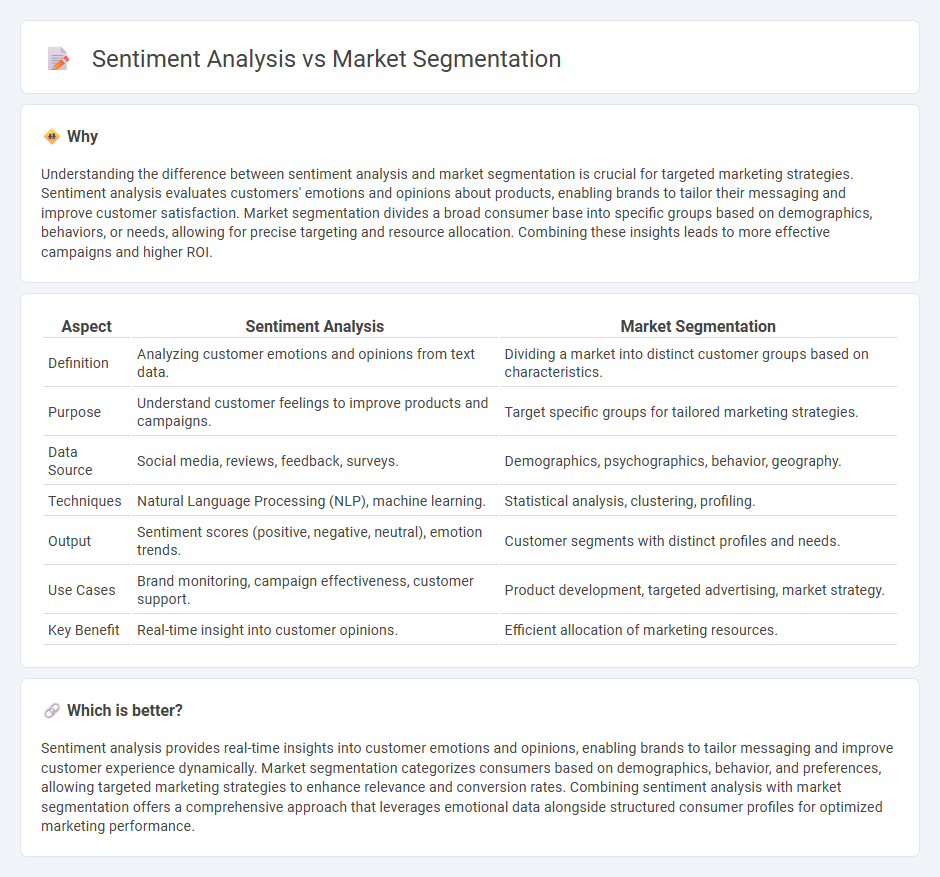
Sentiment analysis leverages natural language processing to evaluate consumer emotions and opinions from social media, reviews, and feedback, providing real-time insights into brand perception. Market segmentation divides a broad target market into smaller, more manageable groups based on demographics, behavior, or psychographics to tailor marketing strategies effectively. Explore how these powerful tools can transform your marketing approach for optimal customer engagement.
Why it is important
Understanding the difference between sentiment analysis and market segmentation is crucial for targeted marketing strategies. Sentiment analysis evaluates customers' emotions and opinions about products, enabling brands to tailor their messaging and improve customer satisfaction. Market segmentation divides a broad consumer base into specific groups based on demographics, behaviors, or needs, allowing for precise targeting and resource allocation. Combining these insights leads to more effective campaigns and higher ROI.
Comparison Table
| Aspect | Sentiment Analysis | Market Segmentation |
|---|---|---|
| Definition | Analyzing customer emotions and opinions from text data. | Dividing a market into distinct customer groups based on characteristics. |
| Purpose | Understand customer feelings to improve products and campaigns. | Target specific groups for tailored marketing strategies. |
| Data Source | Social media, reviews, feedback, surveys. | Demographics, psychographics, behavior, geography. |
| Techniques | Natural Language Processing (NLP), machine learning. | Statistical analysis, clustering, profiling. |
| Output | Sentiment scores (positive, negative, neutral), emotion trends. | Customer segments with distinct profiles and needs. |
| Use Cases | Brand monitoring, campaign effectiveness, customer support. | Product development, targeted advertising, market strategy. |
| Key Benefit | Real-time insight into customer opinions. | Efficient allocation of marketing resources. |
Which is better?
Sentiment analysis provides real-time insights into customer emotions and opinions, enabling brands to tailor messaging and improve customer experience dynamically. Market segmentation categorizes consumers based on demographics, behavior, and preferences, allowing targeted marketing strategies to enhance relevance and conversion rates. Combining sentiment analysis with market segmentation offers a comprehensive approach that leverages emotional data alongside structured consumer profiles for optimized marketing performance.
Connection
Sentiment analysis provides valuable insights into customer emotions and opinions, enabling more precise market segmentation based on consumer attitudes. By analyzing social media posts, reviews, and feedback, businesses can identify distinct segments with varying preferences and needs. These insights allow marketers to tailor campaigns effectively, increasing engagement and conversion rates within each targeted group.
Key Terms
Demographic Segmentation
Demographic segmentation divides the market based on criteria such as age, gender, income, education, and occupation to target specific consumer groups effectively. Sentiment analysis interprets consumer emotions and opinions within these demographic segments to tailor marketing strategies that resonate more deeply with each group's preferences. Explore comprehensive insights on leveraging demographic segmentation and sentiment analysis for precision marketing.
Psychographic Segmentation
Psychographic segmentation categorizes consumers based on their lifestyles, values, interests, and personality traits to tailor marketing strategies effectively. Sentiment analysis, on the other hand, examines consumer emotions and opinions from textual data, providing insights into attitudes and preferences within these psychographic groups. Explore how integrating psychographic segmentation with sentiment analysis can enhance customer understanding and marketing precision.
Opinion Mining
Market segmentation divides a broad consumer or business market into sub-groups based on shared characteristics such as demographics, behavior, or preferences, enabling targeted marketing strategies. Sentiment analysis, a component of opinion mining, involves computationally identifying and categorizing opinions expressed in text to determine the attitude toward products, services, or brands. Explore how integrating market segmentation with sentiment analysis can enhance customer insights and optimize marketing efforts.
Source and External Links
Market segmentation - Wikipedia - Market segmentation is the process of dividing a market into meaningful sub-groups or segments based on shared characteristics such as needs, lifestyles, or demographics, aiming to identify profitable segments that can be targeted with tailored marketing strategies.
What is Market Segmentation? A Guide | Salesforce US - Market segmentation divides a broad target market into smaller groups based on shared attributes including demographic, psychographic, behavioral, and geographic factors to tailor marketing strategies effectively.
What is market segmentation? | Overview and examples - Market segmentation divides a broad target market into distinct clusters of customers with common traits, allowing marketers to create targeted messaging and optimize campaigns for each group.
 dowidth.com
dowidth.com